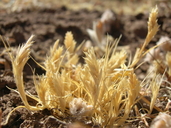Taxon Report
Tuctoria greenei (Vasey) J. ReederGreene's tuctoria |
 ©2008 F. Gauna |
Taxon Summary
Tuctoria greenei, commonly known as Greene's tuctoria, is a annual herb in the Poaceae that is found only in California. It occurs within Vernal pools, growing at elevations from 30 to 1070 meters. Tuctoria greenei is ranked 1B.1, Plants Rare, Threatened or Endangered in California and Elsewhere; Seriously threatened in California.Classification
|
Scientific Name: |
Tuctoria greenei (Vasey) J. Reeder |
|
Common Name: |
Greene's tuctoria |
| Family: | Poaceae |
| Element Code: | PMPOA6N010 |
| USDA Plants Symbol: | TUGR |
|
Synonyms/Other Names: |
|
Ecology and Life History
| Lifeform: | annual herb |
| Blooming Period: May-Jul(Sep) | May-Jul(Sep) |
| Elevation: | 30-1070 (100-3510) |
| General Habitats: | Vernal pools |
| Microhabitat: | |
| Microhabitat Details: |
Conservation Status
| CA Rare Plant Rank: | 1B.1 |
| Global Rank: | G1 |
|
State Rank: |
S1 |
| State List: | CR |
| Fed List: | FE |
| Other Status: | |
|
CRPR Changes: |
|
Occurrence Data from the CNDDB
| Total Occurrences: | 50 |
| Element Occurrence Ranks: | |
| Excellent (A) | 3 |
| Good (B) | 12 |
| Fair (C) | 6 |
| Poor (D) | 5 |
| None (X) | 19 |
| Unknown (U) | 5 |
| California Endemic: True | |
| California Counties and Islands: Name (Code) | |
| Butte (BUT), Fresno (FRE)*, Glenn (GLE), Madera (MAD)*, Merced (MER), Modoc (MOD), San Joaquin (SJQ)*, Shasta (SHA), Stanislaus (STA)*, Tehama (TEH), Tulare (TUL)* | |
| Quads: Name (Quad Code) | |
| Biggs (3912146), Clovis (3611976)*, Cooperstown (3712065)*, Donica Mtn. (4112132), Escalon (3712078)*, Farmington (3712088)*, Hamlin Canyon (3912166), Haystack Mtn. (3712043), Kismet (3712011)*, Le Grand (3712022), Llano Seco (3912158), Logandale (3912242), Montpelier (3712056)*, Murken Bench (4012174), Nord (3912178), Owens Reservoir (3712032), Paulsell (3712066)*, Peters (3712181), Planada (3712033), Richardson Springs NW (3912188), Round Mountain (3611975)*, Sanger (3611965), Shippee (3912156), Vina (3912281), Waterford (3712067)*, Woodlake (3611941)* | |
Threat List Data from the CNDDB
| Threat List Total: | 12 | |
| EOs with Threat Listed: | Total EOs | % of EOs |
| 42 | 84 % | |
| Grazing | 29 | 58% |
| Agriculture | 20 | 40% |
| Non-native plant impacts | 13 | 26% |
| Foot traffic/trampling | 5 | 10% |
| Disking | 3 | 6% |
| Development | 2 | 4% |
| Altered flood/tidal/hydrologic regime | 2 | 4% |
| Biocides | 1 | 2% |
| Other | 1 | 2% |
| Road/trail construction/maint. | 1 | 2% |
| Surface water diversion | 1 | 2% |
| Mining | 1 | 2% |
Notes
|
Threatened by agriculture, urbanization, overgrazing, and habitat fragmentation and loss. See Botanical Gazette |
|
Threats: |
|
Taxonomy: |
Citation
California Native Plant Society, Rare Plant Program. 2025. Rare Plant Inventory (online edition, v9.5.1). Website https://www.rareplants.cnps.org [accessed 21 December 2025].